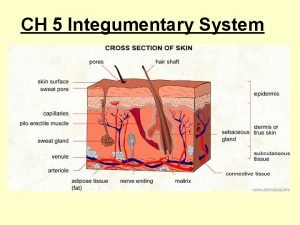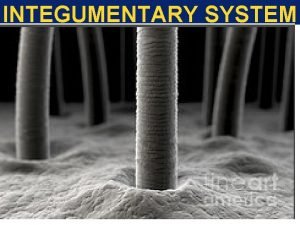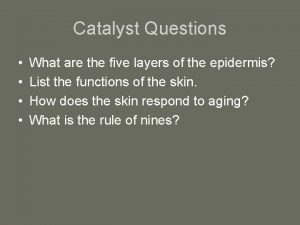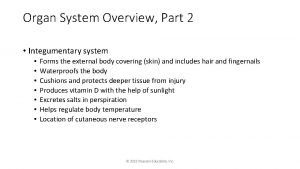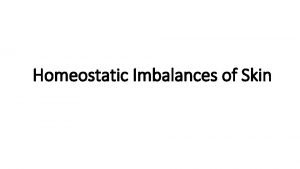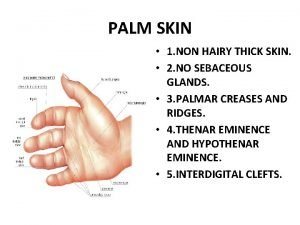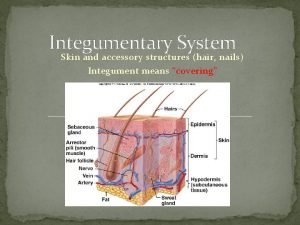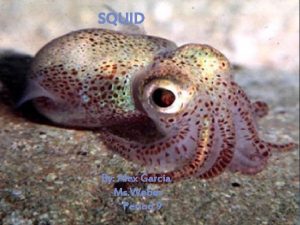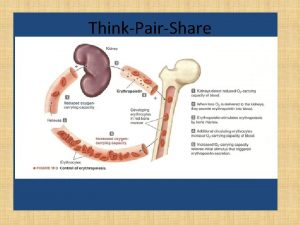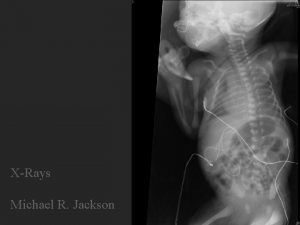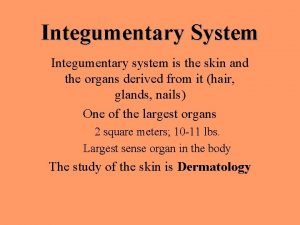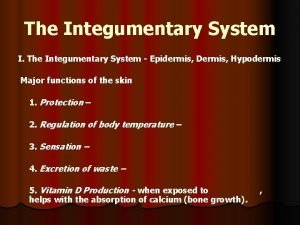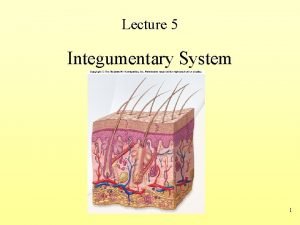Integumentary System Dr Michael P Gillespie Integumentary System






















































- Slides: 54

Integumentary System Dr. Michael P. Gillespie

Integumentary System w The skin (cutaneous membrane) covers the external surface of the body. w It is the largest organ of the body in terms of both surface area and weight.

Functions of the Integumentary System w Thermoregulation w Reservoir for blood w Protection from external environment w Cutaneous sensations w Excretion and absorption w Vitamin D synthesis

Structure of the Skin w Two main parts n n Epidermis – epithelial tissue Dermis – connective tissue w Subcutaneous layer (hypodermis) – not part of the skin – areolar and adipose tissue n Contains nerve endings called lamellated (Pacinian) corpuscles


Epidermis w Keratinized squamous epithelium w 4 types of cells w 5 basic layers of the epidermis

Cell Types in Epidermis w Keratinocytes (90%) n n Keratino = hornlike; cytes = cells Keratin –protects from heat, microbes, and chemicals w Melanocytes (8%) n n Melano = black Produce pigment melanin – absorbs UV light w Langerhans cells n n Arise from red bone marrow – migrate to epidermis Immune response w Merkel cells n Tactile (Merkel) disc


Layers of Epidermis w Stratum Basale w Stratum Spinosum w Stratum Granulosum w Stratum Lucidum w Stratum Corneum


Stratum Basale w Deepest layer w Single row of columnar or cuboidal keratinocytes w Keratin protects the deep layers from injury w Stem cells w Also known as the stratum germinativum (germ = sprout)

Stratum Spinosum w Spinos = thornlike w 8 – 10 layers of many sided keratinocytes close together w Provides strength and flexibility to the skin

Stratum Granulosum w Middle of the epidermis w Granulos – little grains w 3 -5 layers of flattened keratinocytes w Undergoing apoptosis (cell death) w Lamellar Granules – release a lipid-rich secretion

Stratum Lucidum w Lucid = clear w Present only in the thick skin of the fingertips, palms, and soles w 3 -5 layers of flattened clear, dead keratinocytes

Stratum Corneum w w w Corne = horn or horny 25 – 30 layers of flattened dead keratinocytes Shed and replaced by cells from deeper strata Mostly keratin Between the cells are lipids from lamellar granules – creates water repellent barrier w Protects deep layers from injury w Friction creates a callus – abnormal thickening

Growth of Epidermis w Newly formed cells are pushed to the surface w Accumulate more keratin (keratinization) w Undergo apoptosis w Keratinized cells slough off w 4 weeks

Psoriasis w Common skin disorder w Keratinocytes divide more quickly than normal and shed prematurely (7 -10 days) w Immature keratinocytes make abnormal keratin w Forms flaky, silvery scales w Knees, elbows, and scalp (dandruff) w Tx. Topical ointments, UV phototherapy (decreases cell division)


Dermis w Deeper layer w Mainly connective tissue w Collagen and elastic tissue w Fibroblasts, macrophages, and adipocytes

Dermis Continued… w Papillary region – dermal papillae (papillae = nipples) – indent the epidermis – capillary loops w Corpuscles of touch (Meissner corpuscles) w Free nerve endings – warmth, coolness, pain, tickling, and itching

Dermis continued… w Reticular region (reticul = netlike) – deeper part of dermis w Dense irregular CT w Adipose cells, hair follicles, nerves, sebaceous (oil) glands, sudoriferous (sweat) glands w Striae – streaks – stretch marks w Epidermal ridges – grip / friction – palms, fingers, soles, toes

Types of Skin w Thin skin – covers all surfaces of the body except for the palms, palmar surfaces of the digits, and soles. n Lacks a stratum lucidum w Thick skin – covers the palms, palmar surfaces of the fingers, and soles n Distinct stratum lucidum

Accessory Structure of the Skin w Hair w Skin glands w Nails

Hair w Hair or pili – present on most surfaces except the palms, palmar surfaces of fingers, soles, and plantar surfaces of feet w Shaft – superficial portion – projects from skin w Root – deeper portion – penetrates the dermis and sometimes into the subcutaneous layer w Arrector pili – muscle which pulls on hair shaft causing it to raise – emotional stress (cold or fright)


Conditions w Hirsutism = excessive body hair due to excessive androgens – tumor of the adrenal glands, testes, or ovaries w Androgenic alopecia – male-pattern baldness

Skin Glands w Sebaceous Glands (greasy) – oil glands - typically connected to hair follicles n Secrete sebum – coats hair and keeps it from becoming dry and brittle – keeps skin soft and pliable w Sudoriferous Glands – sweat glands n n Eccrine – throughout skin Apocrine – skin of axilla, groin, areolae and bearded regions w Ceruminous Glands – cer = wax – external ear n Cerumen = earwax – creates sticky body to impede entrance of foreign substances

Nails w Tightly packed, hard, keratinized epidermal cells w Nail body, free edge and nail root w Lunula w Hyponychium – beneath free edge w Eponychium (cuticle) adheres to the lateral margin of the nail wall.


Epidermal Wound Healing w Cells enlarge and migrate across the wound w Contact inhibition – when migrating cells touch one another they stop due a this cellular response


Deep Wound Healing w The injury extends to the dermis and subcutaneous layer w Inflammatory phase n n Blood clot forms Inflammation eliminates wastes and microbes w Migratory phase n Damaged blood vessels begin to regrow w Proliferative phase n n Extensive growth of epithelial cells Deposition of fibroblasts w Maturation phase


Contributions of the Integumentary System w The Integumentary System contributes to the functioning of all other body systems. w Refer to the table on page 155.

Skin Disorders w Skin Cancer w Burns w Pressure Ulcers

Skin Cancer w Almost exclusively caused by excessive exposure to the sun. w Basal cell carcinomas w Squamous cell carcinomas w Malignant Melanomas

Basal Cell Carcinoma

Squamous Cell Carcinoma

Detection of Malignant Melanoma w A Asymmetry n MM lack symmetry w B Border n MM have notched, indented, scalloped, or indistinct borders w C Color n MM have uneven coloration, may contain several colors w D Diameter n MM are typically greater than 6 mm (0. 25 in. ) w E Elevation

Normal Nevus & Malignant Melanoma

Risk Factors for Malignant Melanoma w 1. Skin type n Light skinned individuals who burn, but don’t tan w 2. Skin exposure n Sunny areas, high altitude (UV light), outdoor occupation w 3. Family Hx. w 4. Age w 5. Immunological status n Immunosuppressed individuals have a higher risk of skin cancer

Burns w Tissue damage caused by n n Excessive heat Electricity Radioactivity Corrosive chemicals w Destroy some of the skin’s contributions to homeostasis

Grading of Burns w First-degree burn w Second-degree burn (partial thickness) w Third-degree burn (full thickness)

Systemic Effects of Burns w 1. Large loss of water, plasma, and plasma proteins (causes shock) w 2. Bacterial infection w 3. Reduced circulation of blood w 4. Decreased production of urine w 5. Diminished immune response

Severity of Burns w Determined by the depth of the burn and the extent of the area involved. w According to the American Burn Association a major burn includes: n n n Third-degree burns over 10% Second-degree burns over 25% Third-degree burns over face, hands, feet, or perineum w When the burn area exceeds 70%, more than half of the victims die

Determining the Extent of a Burn w Rule of nines – a quick method for estimating the surface area affected by burns w Lund-Browder method – a more accurate method for assessing the extent of burns


Skin Color w Melanin – causes skin color from pale yellow to black n n Melanocytes produce melanin Freckles and liver spots are accumulations of melanin w Carotene – yellow-orange pigment w Hemoglobin – imparts a red color w Albinism – inability to produce melanin - missing from the hair, eyes, and skin w Vitiligo – loss of melanocytes from patches of skin

Skin Color Clues w Cyanotic – blue - hemoglobin is depleted of oxygen w Jaundice – yellow – buildup of the yellow pigment bilirubin in the blood – usually indicates liver disease w Erythema – red – engorgement of capillaries in the skin – skin injury, heat, infection, inflammation, allergies

Carotonemia

Cyanosis

Jaundice

Vitiligo

Scabies
 Brett gillespie
Brett gillespie Lori gillespie
Lori gillespie Ann gillespie ira
Ann gillespie ira Chuck gillespie
Chuck gillespie Toddler fracture
Toddler fracture Vickie gillespie
Vickie gillespie Duncan gillespie pilot
Duncan gillespie pilot Epidermis
Epidermis Integumentary system vocabulary
Integumentary system vocabulary Integumentary system pig
Integumentary system pig Integument adalah
Integument adalah Integumentary system facts
Integumentary system facts Exercise 7 the integumentary system
Exercise 7 the integumentary system Integumentary system vocab
Integumentary system vocab Integumentary
Integumentary The integumentary system
The integumentary system Integumentary assessment
Integumentary assessment Integumentary system analogy
Integumentary system analogy Cat integumentary system
Cat integumentary system The integumentary system
The integumentary system Integumentary system components
Integumentary system components Effects of aging on the integumentary system
Effects of aging on the integumentary system Section 36-3 the integumentary system
Section 36-3 the integumentary system Integumentary system
Integumentary system Integumentary system
Integumentary system Unit 3 integumentary system
Unit 3 integumentary system Homeostatic imbalances
Homeostatic imbalances Papillary layer of dermis
Papillary layer of dermis 6 functions of the integumentary system
6 functions of the integumentary system Skin cancer
Skin cancer Whats gametes
Whats gametes Integumentary system
Integumentary system Integumeny
Integumeny Integumentary system cpt coding guidelines ppt
Integumentary system cpt coding guidelines ppt Stratum basale
Stratum basale Integumentary system of vertebrates
Integumentary system of vertebrates Integumentary accessory organs
Integumentary accessory organs Integumentary system
Integumentary system Excretory and integumentary system
Excretory and integumentary system Squid integumentary system
Squid integumentary system Digestive system foldable
Digestive system foldable Chapter 6 integumentary system
Chapter 6 integumentary system Chapter 36 skeletal muscular and integumentary systems
Chapter 36 skeletal muscular and integumentary systems Meissner corpuscle
Meissner corpuscle How do you pronounce integumentary
How do you pronounce integumentary Integumentary interactions with other systems
Integumentary interactions with other systems Is earth an open or closed system
Is earth an open or closed system Respiratory digestive and circulatory system
Respiratory digestive and circulatory system Michael jackson x ray
Michael jackson x ray David schwimmer mbti
David schwimmer mbti Michael morahan
Michael morahan Michael maesano
Michael maesano Michael stone pole vaulter
Michael stone pole vaulter Michael ball uc berkeley
Michael ball uc berkeley Michael tholander
Michael tholander















